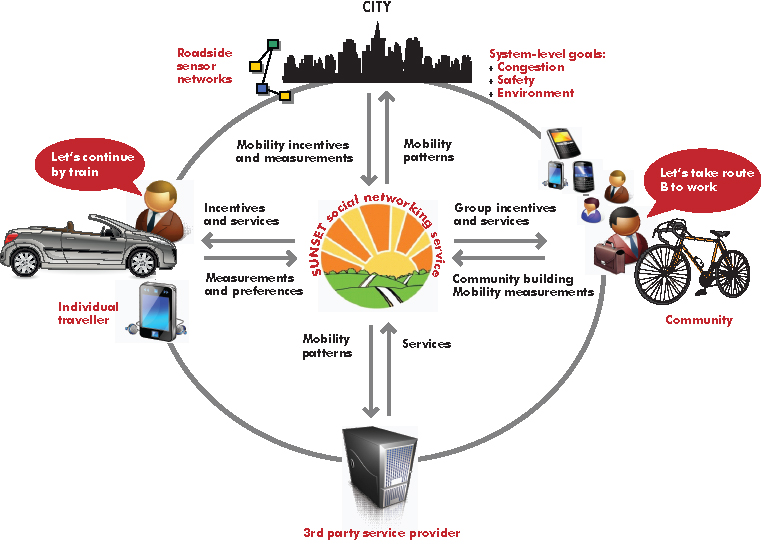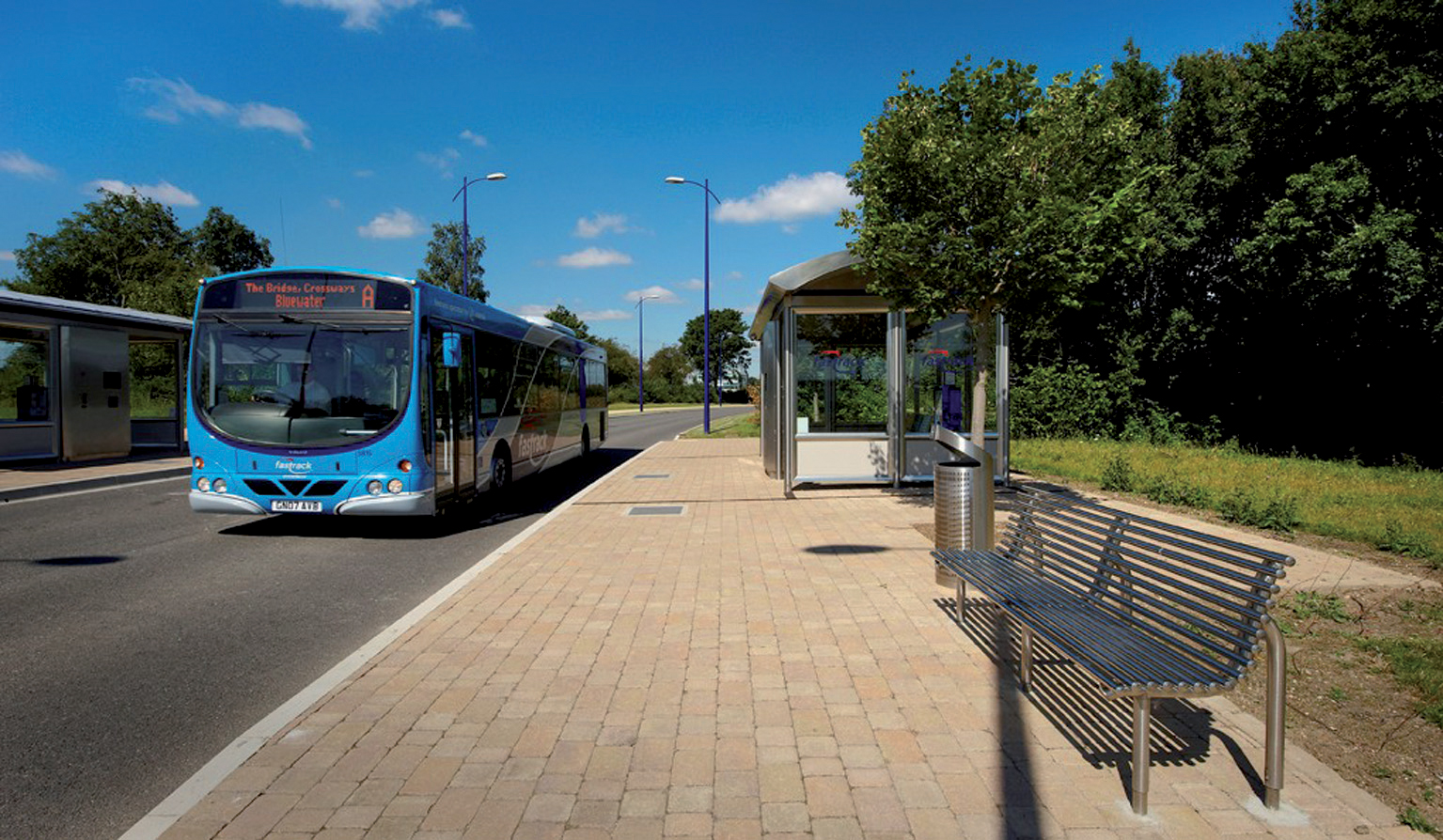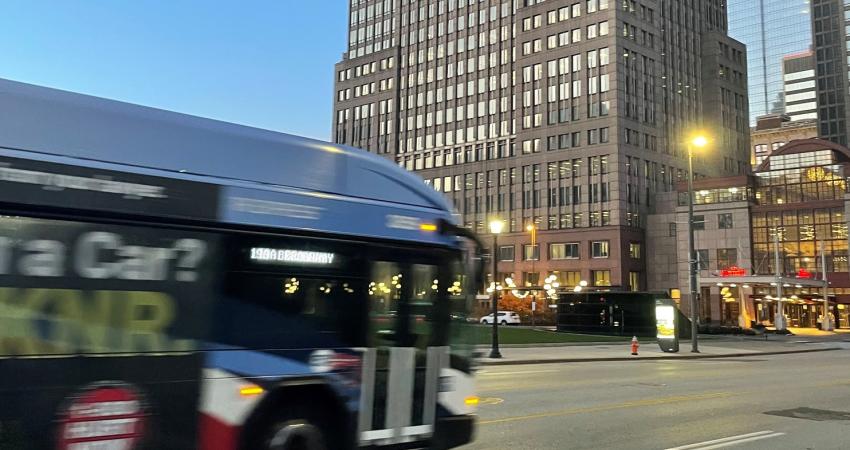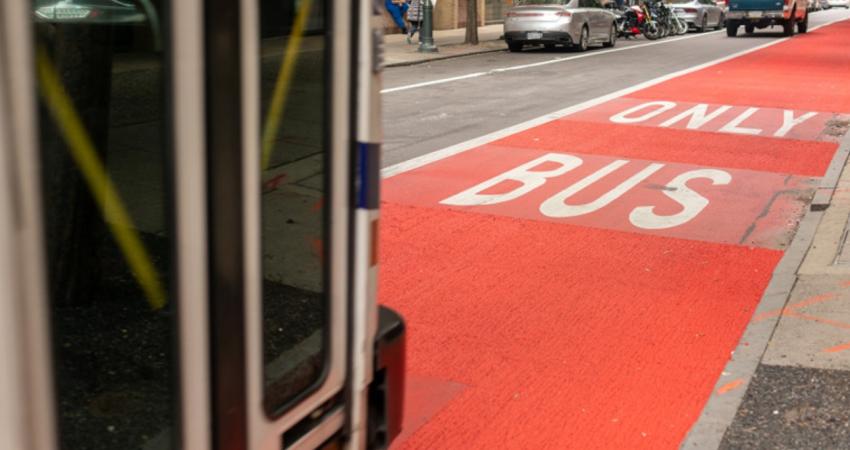Despite its name, the EU's forthcoming SUNSET project could represent a new beginning for travel information services. Here, Susan Grant-Muller and Frances Hodgson from the Institute for Transport Studies at the University of Leeds detail a project which is intended to exert a greater influence on network users' travel habits

Figure 1:
Diagrammatic summary of the information flows within SUNSET
Despite its name, the EU's forthcoming SUNSET project could represent a new beginning for travel information services. Here, Susan Grant-Muller and Frances Hodgson from the Institute for Transport Studies at the University of Leeds detail a project which is intended to exert a greater influence on network users' travel habits
The next generation of Intelligent Transport Solutions (ITS) are likely to involve a step change towards measures that are increasingly based on individual travellers' needs, are less mode-specific and make use of a more sophisticated network of various technologies than is currently the case. There is a growing consensus that further enhancements in enabling ITS technologies may only offer marginal improvements in transport system management unless there is more emphasis on the role of the individual and behavioural change.The
The consortium of partners which will design, build, implement, test and evaluate the SUNSET application includes members from the complete value chain: providers of location-based services; mobile operators; local authorities; green mobility solutions; and well-known research centres. The project is led by
Theoretical development will be needed in the methodology used to assess impacts of a system which will be more dynamic and responsive in comparison to 'traditional' transport infrastructure initiatives. The project goes much further than just developing a prototype and will extend to real-life trials in a number of cities. Its first stage will last for around 18 months and be an iterative process of developing and refining the SUNSET technology in readiness for trial implementation. The second stage will involve 'living labs'. The city of Enschede will become a key living lab, allowing access to its sensor information and facilitating the establishment of a community of companies, but other cities will act as 'reference' cases or locations for further trial implementation. As part of the EU ICT and mobility programme, SUNSET will proactively link and collaborate with other projects. In addition, the consortium has strong links with existing European city networks such as POLIS and there will be a call for further city partners during the first half of the SUNSET project as it will clearly be of great value to the project to obtain information from a range of locations with variation in size, location, state of the art transport system and other variables.
Web 2.0 technology Web 2.0 applications are designed to facilitate interactive information sharing, interoperability, user-centred design and collaboration. In the SUNSET project, this will involve building an interactive community where users are able to share information relating to their own observations and experiences on the road (Figure 1). Road users who encounter heavy traffic, an accident scene or hazardous weather conditions will be able to upload this information instantly.
Web 2.0 also allows users to set unique personal goals tailored to meet their own priorities and motivations. Those wanting to become healthier by walking more, for instance, can record the distance they walk or the number of steps they take each day using phones' inbuilt GPS. If environmental concerns are a priority, the devices can track users' carbon footprints and suggest ways that these can be reduced (Figure 2).
Data will be collected over time so that users can track their progress over the weeks and months of the study. There will be plug-and-play interaction with existing social network platforms, such as
ICT technology SUNSET will also link in with the traffic technology which already exists in many major towns and cities. Roadside sensor networks will collect and share information about real-time traffic conditions at specific locations and feed this directly into the SUNSET platform. As all data will be live, SUNSET will move much more quickly and be far more dynamic than a standard transport project.
The system will also collect data from smartphones' inbuilt GPS technology to create mobility patterns that can be shared in a community portal. This information will be used to generate immediate automatic updates and advice for end users that are specific to their own daily routines and privacy-preserving technology will ensure that personal mobility data is anonymised outside of the secure portal. The movement patterns will also allow local authorities and highways managers to access up-to-the-minute statistics and qualitative information about urban mobility.
The advanced technology of the SUNSET system could even help the transport network keep moving in the case of a major incident or emergency. If a motorway is closed, or there is a flood or an obstruction on a train line, for example, the SUNSET system will provide advice on alternative multi-modal traffic patterns.
Positive incentives One of the most innovative aspects of SUNSET is the use of positive incentives. Many examples of transport policy involve penalising people in some way to change behaviour, for example introducing congestion charges or peak fares on bus and rail networks. SUNSET will examine whether rewarding certain types of behaviour with different incentives can initiate a meaningful change on a large scale.
Incentives will vary depending on the target demographic and the desired outcome. For example, people could be given vouchers for choosing public transport, car-sharing or commuting at different times. Rewards could also be administered as a points system similar to those run by many supermarkets. Using this approach, individuals could accrue points to pay for a chosen incentive such as food, clothes or a free travel pass.
This system could also be used at or during planned events such as major football games or public transport strikes. The system would identify common travel patterns and travel intentions within the local SUNSET community and provide incentives to travel together, thus reducing overall traffic. Local businesses could also provide incentives for their employees who commute together in order to reduce congestion at peak travel times.
The benefits of such an incentive system are twofold. In addition to generating a positive change in behaviour, offering incentives will enable the researchers to find out which incentives chime particularly well with different social demographics. This information will prove extremely useful to future transport planning paradigms.
Expectations It is difficult to predict how the project will be received by members of the public. Only time will tell if the concept of urban mobility management via an interactive smartphone application will be viewed simply as a novelty by end users or whether there will be real long-term benefits.
If the project is a success, it has the potential to completely revolutionise highway management and replace multiple systems and technologies with one coherent, streamlined system. There is also the obvious added benefit of major cost reductions: if SUNSET is successful in generating a permanent shift in people's mentality towards urban mobility it could negate the need to build new bus lanes or widen congested motorways.










